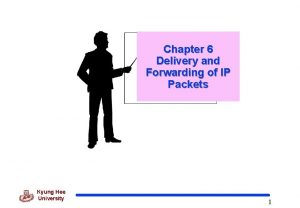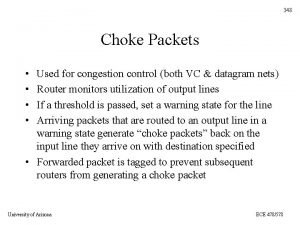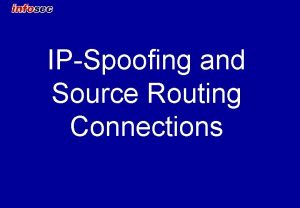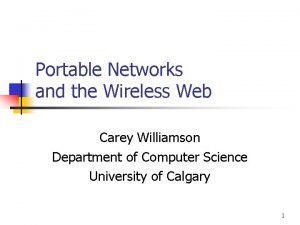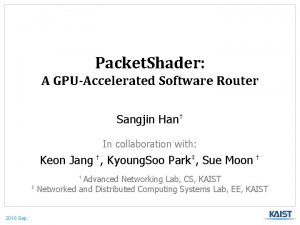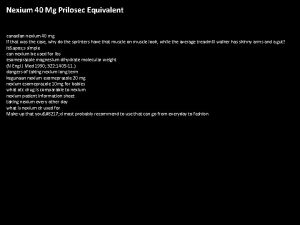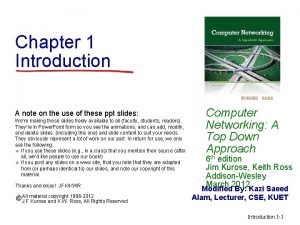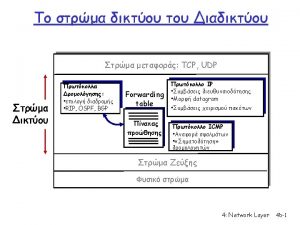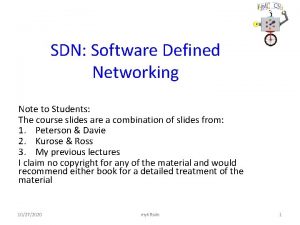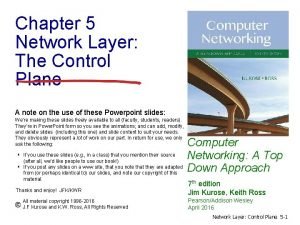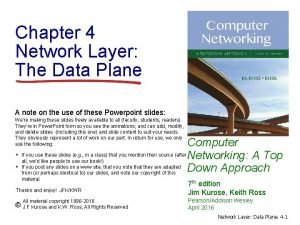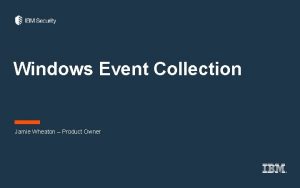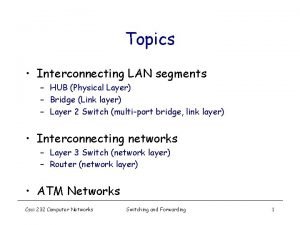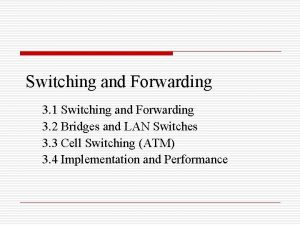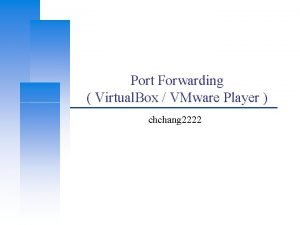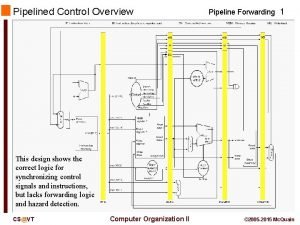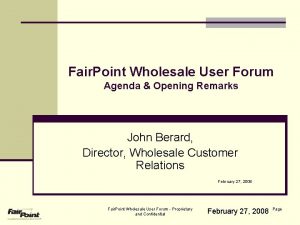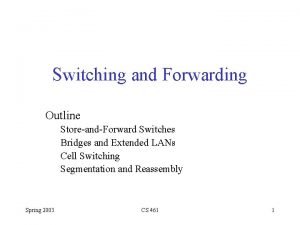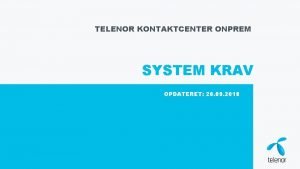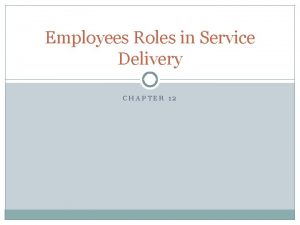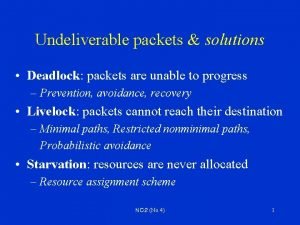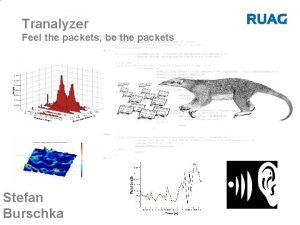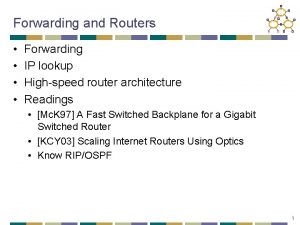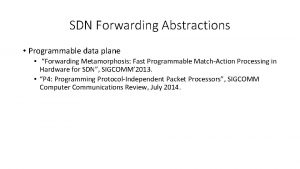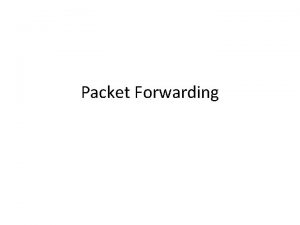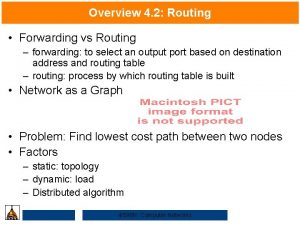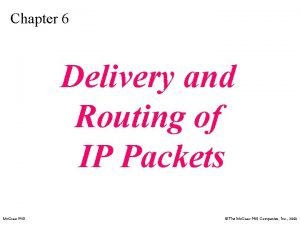Chapter 6 Delivery and Forwarding of IP Packets
















































- Slides: 48

Chapter 6 Delivery and Forwarding of IP Packets Kyung Hee University 1

6. 1 Delivery The network layer supervises the handling of the packets by the underlying physical networks. This handling is called as delivery of a packet The delivery of a packet to its final destination is accomplished using two different methods of delivery : direct and indirect Kyung Hee University 2

Direct Delivery The final destination of the packet is a host connected to the same physical network as the deliverer. Source and destination of the packet are located on the same physical network Delivery between last router and the destination host Extract the network address of the destination and compare this address with the addresses of the networks to which it is connected If a match is found, the delivery is direct The sender uses the destination IP address to find the destination physical address Kyung Hee University 3

Direct Delivery Kyung Hee University 4

Indirect Delivery The destination host in not on the same network as the delivery The packet goes from router to router until it reaches the one connected to the same physical network The sender uses the destination IP address and a routing table to find IP address of the next router Kyung Hee University 5

Indirect Delivery Kyung Hee University 6

6. 2 Forwarding means to place the packet in its route to its destination Since the Internet today is made of a combination of links, forwarding means to deliver the packet to the next hop Although IP protocol was originally designed as a connectionless protocol, today the tendency is to use IP as a connection-oriented protocol based on the label attached to an IP datagram Kyung Hee University 7

Forwarding based on destination address Next-hop Network- Specific Method Host-Specific Method Default Method Forwarding Based on Label Kyung Hee University 8

Next-Hop Method One technique to reduce the contents of a routing table The routing table holds only the address of the next hop instead of information about the complete route Kyung Hee University 9

Network Specific Method Reduce the routing table and simplify the searching process The routing table has only one entry that defines the address of the destination network itself Kyung Hee University 10

Host-Specific Method The Destination host address is given in the routing table Inverse of network-specific method When administrator wants to have more control Kyung Hee University 11

Default Method Instead of listing all networks in the entire Internet host can just have one entry called the default Kyung Hee University 12

Simplified Forwarding Module in Classful Address without Subnetting Kyung Hee University 13

Example 6. 1 Figure 6. 8 shows an imaginary part of the Internet. Show the routing tables for router R 1. Solution Figure 6. 9 shows the three tables used by router R 1. Note that some entries in the next-hop address column are empty because in these cases, the destination is in the same network to which the router is connected. In these cases, the next-hop address used by ARP is simply the destination address of the packet as we will see in Chapter 8. Kyung Hee University 14

Figure 6. 8 Configuration for routing Kyung Hee University 15

Figure 6. 9 : Table for Example 6. 1 Kyung Hee University 16

Example 6. 2 Router R 1 in Figure 6. 8 receives a packet with destination address 192. 16. 7. 14. Show the packet is forwarded. Solution The destination address in binary is 11000000 000100000111 00001110. A copy of the address is shifted 28 bits to the right. The result is 00000000 00001100 or 12. The destination network is class C. The network address is extracted by making off the left-most 24 bits of the destination address; the result is 192. 16. 7. 0. The table for Class C is searched. The network address is found in the first row. The next-hop address 111. 15. 17. 32 and the interface m 0 are passed to ARP(see Chapter 8) Kyung Hee University 17

Simplified Forwarding Module in Classful Address with Subnetting Kyung Hee University 18

Example 6. 4 Figure 6. 11 shows a router connected to four subnets. Note several points. First, the site address is 145. 14. 0. 0/16 (a class B address). Every packet with destination address in the range 145. 14. 0. 0 to 145. 14. 255 is delivered to the interface m 4 and distributed to the final destination subnet by the router. Second, we have used the address x. y. z. t/n for the interface m 4 because we do not know to which network this router is connected. Third, the table has a default entry for packets that are to be sent out of the site. The router is configured to apply the subnet mask /18 to any destination address Kyung Hee University 19

Figure 6. 11 Configuration for Example 6. 4 Kyung Hee University 20

Simplified Forwarding Module in Classless Address In classful addressing we can have a routing table with three columns; in classless addressing, we need a least four columns Kyung Hee University 21

Example 6. 7 Make a routing table for router R 1 using the configuration in following Figure 6. 13 Kyung Hee University 22

Routing Table for router R 1 in previous Figure Solution Mask Network Address Next Hop Interface /26 180. 70. 65. 192 - m 2 /25 180. 70. 65. 128 - m 0 /24 201. 4. 22. 0 - m 3 /22 201. 4. 16. 0 …. m 1 Default 180. 70. 65. 200 m 2 Kyung Hee University 23

Example 6. 8 Show the forwarding process if a packet arrives at R 1 in Figure 6. 13 with the destination address 180. 70. 65. 140. Solution The router performs the following steps: 1. The first mask(/26) is applied to the destination address. The result is 180. 70. 65. 128, which does not match the corresponding network address. 2. The second mask(/25) is applied to the destination address. The result is 180. 70. 65. 128, which matched the corresponding network address. The next-hop address and the interface number m 0 are passed to ARP Kyung Hee University 24

Example 6. 11 Can we find the configuration of a router if we know only its routing table? The routing table for router R 1 us given in Table 6. 2. Can we draw its topology? Solution We know some facts but we don’t have all for a define topology. We know that router R 1 has three interface: m 0, m 1, and m 2. We know that there are three notworks directly connected to router R 1. We know that there are two networks indirectly connected to R 1. There must be at least three other router involved. We know to which networks these routers are connected by looking at their IP addresses. So we can put them at their appropriate place. We know that one router, the default router, is connected to the rest of the Internet. But there is some missing information. We do not know if network 130. 4. 8. 0 is directly connected to router R 2 or through a point-to-point network (WAN) and another router. We do not know if network 140. 6. 12. 64 is connected to router R 3 directly or through a point-to-point network and another router. Point-to-point networks normally do not have an entry in the routing table because no hosts are connected to them. Figure 6. 14 shows our guessed topology Kyung Hee University 25

Routing Table for Example 6. 11 : Table 6. 2 Mask Network Address Next Hop Address Interface Number /26 140. 6. 12. 64 180. 14. 2. 5 m 2 /24 130. 4. 8. 0 190. 17. 6. 2 m 1 /16 110. 70. 0. 0 - m 0 /16 180. 14. 0. 0 - m 2 /16 190. 17. 0. 0 - m 1 Default 110. 70. 4. 6 m 0 Kyung Hee University 26

Guessed Topology for Example 6. 11 Kyung Hee University 27

Address Aggregation The increased size of the table results in an increase in the amount of time needed to search the table Kyung Hee University 28

Longest Mask Matching Routing table is sorted from the longest mask to the shortest mask. Kyung Hee University 29

Routing Hierachical Routing To solve the problem of gigantic routing table. If the routing table has a sense of hierarchy like the Internet architecture, the routing table can be decrease in size Geographical Routing Divide the entire address space into a few large block - US, EU, Asia, Africa and so on Routing table search algorithms See the Chapter 11 Kyung Hee University 30

Example 6. 12 As an example of hierarchical routing, let us consider Figure 6. 17. A regional ISP is a granted 16, 384 addresses starting from 120. 14. 64. 0. The regional ISP has decided to divide this block into 4 subblocks, each with 4096 addresses. Three of these subblock are assigned to three local ISPs, the second subblock is reserved for future use. Note that the mask for each block is /20 because the original block with mask /18 is divided into 4 blocks. Kyung Hee University 31

Hierarchical Routing with ISPs Kyung Hee University 32

Forwarding Based on Label Change IP to behave like a connection-oriented protocol in witch the routing is replaced by switching Kyung Hee University 33

Example 6. 13 Figure 6. 18 shows a simple example of searching in a routing table using the longest match algorithm. Although there are some more efficient algorithms today, the principle is the same. When the forwarding algorithm gets the destination address of the packet, it needs to delve into the mask column. For each entry, it needs to apply the mask to find the destination network address. It then needs to check the network addresses in the table until it finds the match. The router then extracts the next-hop address and the interface number to be delivered to the ARP protocol for delivery of the packet to the next hop. Kyung Hee University 34

Figure 6. 18 : Forwarding based on Destination Address Kyung Hee University 35

Example 6. 14 Figure 6. 19 shows a simple example of using a label to access a switching table. Since the labels are used as the index to the table, finding the information in the table is immediate. Kyung Hee University 36

Figure 6. 19 : Forwarding based on Label Kyung Hee University 37

MPLS(Multi-Protocol Label Switching) During the 1980 s, several vendors created routers that implement switching technology. When behaving like a router, MPLS can forward the packet based on the destination address; when behaving like a switch, it can forward a packet based on label. A new header is needed MPLS header added to an IP packet Kyung Hee University 38

MPLS header made of stack of labels Label : This 20 -bit a field defines the label that is used to index the routing table in the router Exp : This 3 -bit field is reserved for experimental purposes S : The one-bit stack field defines the situation of the subheader in the stack. When the bit is 1, it means that the header is the last one in the stack TTL : 8 -bit field, similar to the TTL field in the IP datagram Kyung Hee University 39

6. 3 Structure of a Router is Black box that accepts incoming packets, uses a routing table to find the output port, and sends the packets In this section, Open the black box and look inside. But this is a just an review and our discussion will not be very detaoled. Kyung Hee University 40

Router Component Kyung Hee University 41

Input Port Perform the physical and data link layer functions of router Kyung Hee University 42

Output Port Perform the same function as the input port, but in reverse order Kyung Hee University 43

Routing Processor and Switching Fabric Routing Processor Perform the functions of the network layer The destination address is used to find the address of next hop and the output port number from which the packet is sent out Switching Fabric The most difficult task in a router Move the packet from the input queue to output queue Routers use a variety of switching fabrics Kyung Hee University 44

Crossbar Switch Connects n inputs to n outputs in a grid Using electronic microswitches at each cross point Kyung Hee University 45

Banyan Switch Kyung Hee University 46

Example of routing in a banyan switch Arrange arrival packets according to output ports Kyung Hee University 47

Batcher-banyan Switch Kyung Hee University 48
 Delivery and routing of ip packets
Delivery and routing of ip packets Delivery and forwarding of ip packets
Delivery and forwarding of ip packets Late packets
Late packets Choke packet in congestion control
Choke packet in congestion control Ipcop addons
Ipcop addons Drop source routed ip packets
Drop source routed ip packets Thieves cleaner packets
Thieves cleaner packets Softnet packets
Softnet packets Broadcasts packets, but creates loops in the systems.
Broadcasts packets, but creates loops in the systems. Losing packets
Losing packets Shader
Shader Nexium coupon canada
Nexium coupon canada The diagram shows the circle with equation x^2+y^2=261
The diagram shows the circle with equation x^2+y^2=261 They relay packets among multiple interconnected networks
They relay packets among multiple interconnected networks Accenture delivery suite (ads) support?
Accenture delivery suite (ads) support? Interplay between routing and forwarding
Interplay between routing and forwarding Examples of sdn
Examples of sdn Internal forwarding and register tagging
Internal forwarding and register tagging Generalized forwarding and sdn
Generalized forwarding and sdn Generalized forwarding and sdn
Generalized forwarding and sdn Qradar msrpc
Qradar msrpc Forwarding table example
Forwarding table example Forwarding table example
Forwarding table example Rcn call manager
Rcn call manager App portic
App portic Vmware fusion port forwarding
Vmware fusion port forwarding Forward equivalence class
Forward equivalence class Adobe audience manager sync
Adobe audience manager sync Forwarding computer architecture
Forwarding computer architecture Palo alto policy based forwarding
Palo alto policy based forwarding Datagram forwarding table
Datagram forwarding table Email advantages and disadvantages
Email advantages and disadvantages Forwarding email etiquette
Forwarding email etiquette Forwarding paths pipeline
Forwarding paths pipeline Forwarding state
Forwarding state Hisilicon technologies co. ltd
Hisilicon technologies co. ltd Fairpoint call forwarding
Fairpoint call forwarding Spectrum call forwarding
Spectrum call forwarding Forwarding table
Forwarding table App portic forwarding
App portic forwarding Dhl seafreight
Dhl seafreight Telenor port forwarding
Telenor port forwarding Protocol oblivious forwarding
Protocol oblivious forwarding Kar freight & forwarding
Kar freight & forwarding Dreamhost email forwarding to gmail
Dreamhost email forwarding to gmail Squad port forwarding
Squad port forwarding Centrex call forwarding
Centrex call forwarding Employees roles in service delivery
Employees roles in service delivery Customers role in service delivery
Customers role in service delivery
